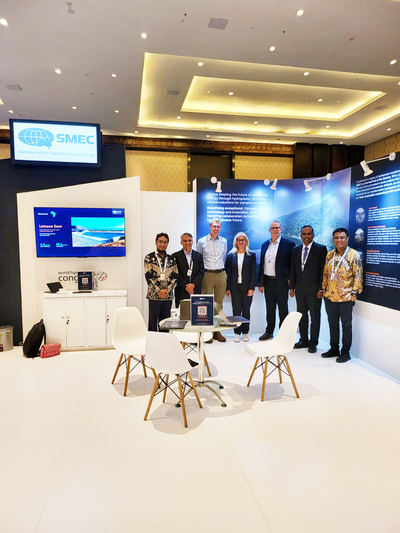This post was originally published on Sustainability Matters

Hydropower is a cornerstone of sustainable energy solutions. It promotes environmental responsibility, economic stability and energy reliability as the world continues to shift towards a sustainable and environmentally responsible future.
As a technology, hydropower provides essential grid stability and energy storage capabilities, enabling the seamless integration of intermittent renewable sources like wind and solar. Simultaneously, contributing to climate change mitigation through water resource management, flood control, and ecosystem restoration in well-planned and sustainable initiatives.
SMEC is advancing hydropower projects globally by utilising innovative designs and technologies that emphasise environmental sustainability, enabling the harnessing of renewable energy from flowing water, redefining the renewable energy landscape.
In October 2023, the International Hydropower Association (IHA) held the World Hydropower Congress in Bali where SMEC’s Karen Atkinson (Chief Operating Officer, South East Asia (SEA) Division) and Bob Tilbury (Market Director – Water), were among the presenters. Both shared their insights on current projects and contributing to the ongoing dialogue on the role and urgency for sustainable energy solutions.
Globally, there are key actions required within hydropower and the renewables sector more broadly to help achieve net-zero goals by 2050.
Acknowledging industry challenges with a sense of urgency
Despite its immense potential, the hydropower industry faces significant challenges, especially as emphasis shifts to the transition from global warming to the more immediate ‘global boiling’ scenario. This term, which Indonesian President Jokowi Widodo used in his opening remarks, shows the escalation in urgency for action to address climate risks. SMEC recognises the pressing issues of perceptions, financing, market mechanisms for capacity and firming, and industry capacity in consulting and construction. Perception-related issues involve concerns such as the environmental impact of hydropower and potential displacement of communities. Addressing these hurdles is imperative to unleash the full potential of hydropower as a sustainable energy source and to address the immediate environmental challenges posed by the climate crisis.
Actionable steps for industry advancement
The Congress highlighted three pivotal actions imperative for driving the industry forward, calling for collective efforts and individual engagement. SMEC advocates for industry-wide dissemination of knowledge, and advocacy for essential policies, regulations, and market mechanisms. Sharing lessons and best practices related to financing and sustainable contracting models will be crucial in propelling the industry’s growth. Additionally, supporting organisations like IHA, pivotal in promoting the industry and addressing climate change, is critical for industry advancement.
Embracing sustainable hydropower
SMEC firmly endorses the IHA-authored San Jose Declaration and Bali Statement, underscoring the importance of sustainable hydropower as the driver for green industrial growth. This commitment aligns with the milestone launch of the Hydropower Sustainability Alliance (HAS) at the Congress, an initiative dedicated to enhancing transparency and trust through a rigorous Hydropower Sustainability Standard, combining efforts from both public and private sectors to certify sustainability, ensuring a mutual understanding between civil society and hydropower developers. This emphasises the imperative need for sustainable policies and standards for the industry’s global well-being.
Message to COP 28: a call for collaborative progress
The message conveyed at the Congress to COP 28 is clear: the future of hydropower lies in sustainable development, recognising that green economic growth cannot occur without the pivotal role of hydropower. A key outcome of the Congress; the Bali Statement stresses that sustainable hydropower should be the backbone of national strategies fostering low-carbon economies, especially in regions like ASEAN where substantial hydropower potential exists.
However, success in these areas hinges on strong governmental and financial support, recognising and understanding the significance of present and future renewable energy landscapes, and delivering hydropower projects that meet the Hydropower Sustainability Standard. SMEC advocates for the transition towards a future where sustainable growth is propelled by water, wind, and solar energy collectively. Emphasising the integration of pumped storage with solar and wind, SMEC believes that sustainable development is the path to achieving net-zero goals by 2050.
The imperative of collective action
The future of hydropower relies on collaborative efforts. It is imperative for all stakeholders to unite and work together to tackle the challenges impeding sustainable development in the industry. Collective action is fundamental in steering the industry towards a prosperous and sustainable future. Karen Atkinson, who delivered SMEC’s closing statement at the high-level Stakeholder Forum, highlighted this critical insight, stating, “Embracing sustainable hydropower as the fundamental driver is not just a choice; it is an imperative for the future of our planet.”
The World Hydropower Congress provided invaluable perspectives and directions for the future. The event emphasised the pivotal role of sustainable hydropower, advocating for concerted efforts, strategic alliances, and workforce transformation to drive the industry toward a sustainable, prosperous future. As a business SMEC stands poised to incorporate these insights into its strategies, continuing its commitment to fostering sustainable development and innovation in the hydropower sector.
Following the IHA World Hydropower Congress and COP28 there is hope that through a global collaborative approach, effective change can be achieved. At COP28, IHA announced that 125 countries have pledged to triple the total global renewable power capacity by 2030 to at least 11,000 GW and doubling energy efficiency improvement rates to be in with a hope of meeting 1.5°C goals. To achieve this, hydropower has a crucial role to play.
SMEC is proud of the technical expertise which our teams bring to this challenge and the role the engineering industry will play in shaping the global energy landscape, creating sustainable, secure, and prosperous communities for all.





0 Comments